Horrific Inquiry: THE CABINET OF DR. CALIGARI (1920)
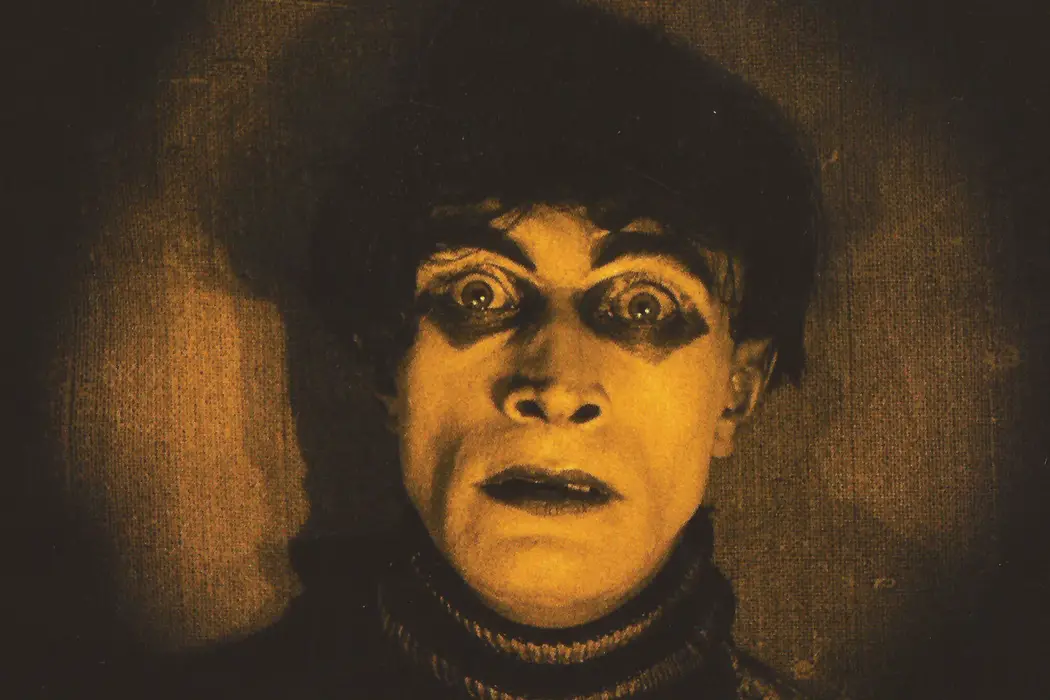
Stephanie Archer is 39 year old film fanatic living in…
Welcome back to the newest, and at times goriest, column here at Film Inquiry – Horrific Inquiry. Twice a month, I will be tackling all things horror, each month bringing two films back into the spotlight to terrify and frighten once more. And occasionally looking at those that could have pushed the envelope further. Join us as we dive deep into the heart of horror, but warning, there will be spoilers.
Celebrating the 100th anniversary of its New York premiere in April, The Cabinet of Dr. Caligari, from Robert Wiene, is a film held close to the hearts of film historians, German expressionists, and horror fans alike. Premiering in Germany in 1920, The Cabinet of Dr. Caligari is a must-see for any film lover.
A Story of Madness
The Cabinet of Dr. Caligari begins with a young man, Franzis (Friedrich Feher), regaling a tale of his past, a time when a mysterious traveler arrived bringing mysticism and horror to his town and his beloved. Iris lenses help the audience focus on his face – on his expressions – protected from the distractions the set may have created. The lens also works to transition between the past and the present – or as we will discover, between reality and imaginary.
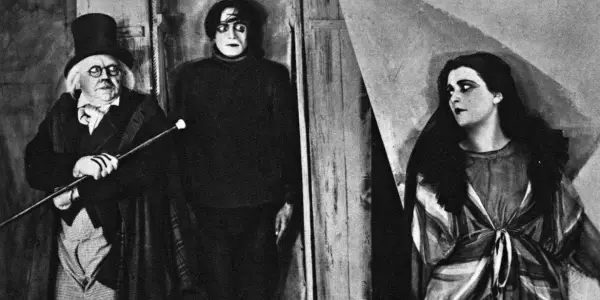
As we are thrown into the town, the first shot is as if we are looking at a painting, the town “placed” at what feels like the back of a stage. As the film introduces the town, Dr. Caligari (Werner Krauss) is immediately introduced hoping to obtain a permit to showcase his cabinet of wonders to the town’s inhabitants. He is introduced in the title cards as the film’s mountebank, defined as a person who deceives. And deceive he does.
Layering his deception, Dr. Caligari invites the festival’s spectators to take in the wonder of Cesare (Conrad Veidt) as he is awoken for the first time in 25 years. As he brings, Cesare to “life”, he informs the audience that any question they ask will be answered by the young man. One brave soul steps forth, only to be told that he will be dead by dawn. The horror of his prophecy strikes the hearts of many, especially as it is made the day following a mysterious murder in town – and is proceeded by the prophesied death of Alan (Hans Henrich von Twardowski).
As the story weaves around the discovery of the mysterious killer and origins of Dr. Caligari, viewers are eventually brought to the local asylum where every aspect of the film is thrown into question and the true identity of the mad man is revealed.
Crafting a Historical Classic
One of the first things you notice within The Cabinet of Dr. Caligari is the highly expressive nature of the film’s actors, compensating for the lack of sound – not only in expressions but with gestures and behaviors as well. Each movement is intentional and exaggerated, much as you would find on stage, speaking to the transition that was currently happening at the time between theater and film.
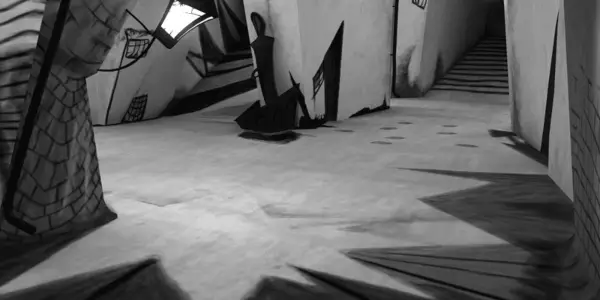
Further speaking to the transition from stage to screen is the stationary camera. The camera does not move, does not give the multiple angles we are accustomed to. It is a fixed mark, characters moving in to frame with the sets changing altogether. Though in a sense, looking back at the limitations it provided to filmmakers, it also made the transition easier for audiences. They too are a fixed mark, sitting in their seats, theater productions moving on the stage from right or left.
In the early days of film, the iris lens was a central part of filmmaking. Here, while it is repeatedly utilized, its use finds deeper meaning with each take. Initially, the iris lens is continually used to focus the audience’s attention on one person or detail, closing out distractions and maintaining your attention. But the iris lens, unlike the camera, is not stagnant, morphing to adapt to fully capture the film’s meaning and intent. The iris lens is also a transitional editing technique opening the door to the past and to a false reality, the roundness of its shapes immediately contrasting the sharp edges of the film’s set design and lighting. It finds use as well, outside of the film, helps to create a movie space and an audience space – a space for the safety of the viewing audience with such an introduction of horror, but also in a voyeuristic sense.
The Cabinet of Dr. Caligari boasts an impressive and imaginative set design and lighting, speaking metaphorically to the skewed perspective and ability of the mind. As Franzis tells his story of past events, audiences will later find that his recollection is nothing more than the creations of a mad man. With skewed lines, sharp angles, and distorted shapes in design and lighting, the style of The Cabinet of Dr. Caligari would become the first in a series of films within German Expressionism, and become a lasting impression on the horror genre and filmmakers alike.
From the beginning of Franzis’s story, audiences immediately see this imagery, the town is designed by sharp angular lines, triangular shapes, and skewed cubic distortions encompassing the town, further extending into the film’s lighting. Floors, ceilings, and walls each received this treatment, creating an all-encompassing mise en scène. As the film continues, these shapes, edges, and shadows become more prominent, at various moments, the shadows creating points and tips, piercing the white light of the film, as though speaking to the distortion of the mind penetrating the light of truth.
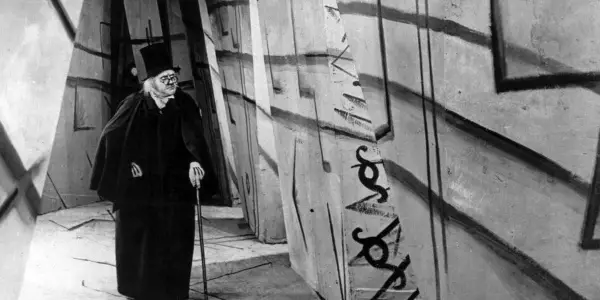
However, there are moments where the sharp lines and skewed shapes are not present – in the home of Jane (Lil Dagover) where the walls are painted with curved half circles, with the moon or sun behind them, the curtains draped in a flowing curvature, and even the couch’s edges curved. This is further contrasted by the halls of the asylum. While the door to Dr. Caligari’s office is triangular and the walls crooked and angular, the paintings on the walls and doors flow and curve much like the painting and curtains in Jane’s room. There is a softness created in them, but also a break from the hard molding of the set design throughout the film’s entirety. Within these curves are the smooth lines of truth.
Many times framing with the film’s actors adds to the mise en scène, pushing the limits of its audience’s attention and stationary camera. Frequently, people are placed within three corners, each with their own reactions and movements, whether they be subtle or overly expressive. This can be seen in the asylum and the police station when the copycat killer is brought in. Further heightening the framing is the occasional appearance of authority figures seated on unusually high chairs – speaking to the distorted perspective of authority.
Hypnosis and war
The Cabinet of Dr. Caligari is a historical picture of the times. War, famine, and psychoanalysis were all at the forefront. Dr. Caligari captures the mindset of this time – fear of control, a desire for normalcy, and the discovery of the human mind. In the early 1900s, Sigmund Freud had gained notoriety for his work in the field of psychology, his theories, and utilization of hypnosis. Not only was there a new force in the acceptance and understanding of the human mind, but there were also newly arising fears of the power hypnosis could yield. While someone could place you under hypnosis to draw out traumas and lost memories of the past, could it also cause one to commit unspeakable acts? And how would one control this abuse of power?
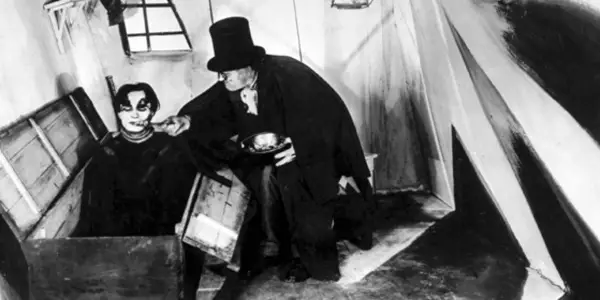
With the expansion in the field of psychology, the “mad man” was thrown into a different light. Was a person ever truly in control of their actions, or did their past and hidden desires control their emotions and actions. This can be seen in the film’s struggle to identify the real “mad man” within the film, leaving audiences with further compounding questions – are we all a little mad?
One of the most insightful moments in the film with regards to its viewpoint on the emerging power and influence of psychoanalysis is when Dr. Caligari has awoken Cesare for the first time, a sinister smile on his face and his glasses resting on his forehead. Here, the glasses function as a third eye. In this exact moment, there is the literal interpretation – Cesare is prophesying the future and Dr. Caligari knows the truth behind this prophecy. But it also speaks to the power of Dr. Caligari to see and extract the truth from the recesses of the mind. He has the power to see the true self in his patients and in those around, whether it be through therapy and understanding or through hypnosis.
Beyond Freud, there is an interesting aspect of the film’s initial murder contrasted to the exuberance of the festival. The first murder is greeted with horror and sadness, the camera holding onto its subjects, its stationary placement forcing us to take in the grievance of human loss. Yet, the film moves quickly back to the festival, an attempt to continue forward and to return to previous times of light-hearted fun and festivities. It is here that a parallel can be drawn between the film and the time period it was created. Premiering in 1920, Germany, as were several other countries, was just coming out of World War I. As much as there was somber air over the loss of life and loss of the war, it is reflected here as a need and a want to return to the joys of prewar times. A strive to push past the death, violence, and destruction and return to normal.
Conclusion: The Cabinet of Dr. Caligari
The Cabinet of Dr. Caligari forces audiences to question – who is the real mad man? While the film may appear outdated, there is a moment of history that can be understood and the embracement of the power of film to be celebrated. And as outdated as the film may feel, its influences are far-reaching. Much of the influences of Dr. Caligari, and German Expressionism, can be seen in the works of Tim Burton, the same similar design to his works seen in films such as Edward Scissorhands, The Nightmare Before Christmas, and Beetlejuice. Even Edward from Edward Scissorhands shares a similarity to the ill-fated Cesare. Even the look of Dr. Caligari feels as though it may have been an inspiration in the final on-screen look of Mad Eye Moody in the Harry Potter series.
It is important to remember the influence The Cabinet of Dr. Caligari has, its place permanently cemented within the dawn of film. A historical classic that may not retain the quality, but still retains the importance.
What are your favorite German Expression films? Let us know in the comments below!
Does content like this matter to you?
Become a Member and support film journalism. Unlock access to all of Film Inquiry`s great articles. Join a community of like-minded readers who are passionate about cinema - get access to our private members Network, give back to independent filmmakers, and more.












